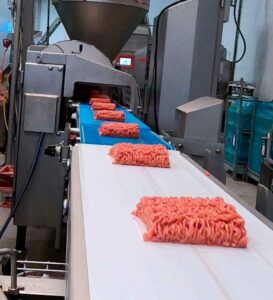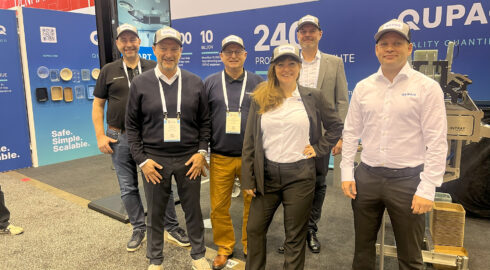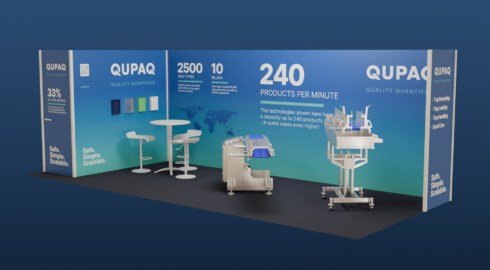Avoid Downtime: Log and Monitor Tray Denesting Success Rate
It is very easy to calculate the success rate: all you have to do is count the number of trays denested per day and the number of errors that occur per day.
Know The metrics of your tray denester
Log and Monitor Tray Denesting Success Rate
Keeping track of the success rate of your tray denesting can give you valuable insight into identifying why problems arise, understanding what their consequences are, and finding solutions to how the running of production lines can be improved.
How does a tray denesting success rate of 99,96% sound to you? That is the success rate QUPAQ currently delivers at Norfersk in Norway. And out of the 0,04% errors that do occur, only a few incidents cause a production stop.
Food Manufacturing is a complex process. Scoping in on the tray denester in the packaging area, you will find that it may not be the most error-prone technology in the entire operation – it rarely is, due to a lot of factors. But it still makes a lot of sense to log and monitor the reasons for tray errors together with the daily count of trays denested to calculate the success rate.
Calculating the Success Rate
It is very easy to calculate the success rate: all you have to do is count the number of trays denested per day and the number of errors that occur per day. An example of this could be:
Trays denested: 43.314
Tray errors: 18
Success rate: 99,96% – 100-(18/(43314/100))
When logging errors you should group the incidents in how severe they were. Did they cause a minor delay or a full production stop? And, if it is possible, you should also log what may have caused the errors.
Altogether, this will give you valuable information for analyzing the behavior and success of your tray denester. And if you have a tray denester from QUPAQ – either INTRAY or ANYTRAY – we can use this information together to improve the operation.

At Norfersk the tray denesting success rate is 99,96% on average. And only few of the faults that do occur cause an actual stop in production.
However, you cannot use Norfersk’s number as a benchmark for your denester’s success rate. The success rate depends on a lot of different factors, all differing from company to company. Therefore, you can only measure your success rate based on the specific factors that apply to your company’s denester.
So, if you feel like the running of your production line could use an optimization after having calculated your success rate, you should of course seek inspiration in the best installations in operation. These improvements could include a change of trays, change of technology or change of capacity.
Read Also: New Equipment on Existing Line
Servo-Driven Denesters Have Auto-Correct
If you consider changing your tray denester, firstly, you should know the metrics of your current installation. Secondly, you should know what goals you wish to set for the new one, and on which parameters these should function. Lastly, you should secure the log history for further dialogue.
If all your tray errors today cause a stop, we would recommend you to be looking towards servo-driven denesters like our INTRAY Smart Buffer – Servo. Servo-driven denesters like this have the ability to “rewind” tray faults and retry the process automatically, eliminating the need for human intervention. This feature ensures that your production line can continue running with minimal disruption, making it a remarkable auto-correct function that brings a lot of convenience.
Servo-driven denesters have the ability to rewind and retry when it detects an error. This auto-correct feature makes it a very reliable choice for tray denesting in a fast paced production line. In the video you can see how the machine corrects a tray error without human interaction.
Reasons for Tray Errors
In most cases tray errors occur due to a misalignment in the nested trays, perhaps due to a sudden convergence in the gap size between the trays. The cause of these errors could stem from the manufacturer, but they could also occur when loading trays into the denesting tool.
Trays often have coded orientations in the nests, which must be considered when a new nest is loaded on top of another. If the coding doesn’t match, it can cause misalignment. Here, sensors could be added to test and secure this when trays are loaded.
Likewise, if the nest in the denester is too high it can put too much weight and strain on the denesting tool, which could cause an error. Therefore, the employees who are feeding nests of trays to the denester should know the limits of the stacks.
If the denesting speed is tuned above what has been promised, it could also cause tray errors, as they may not be able to release and get away from the tool before a new tray is entering.
Lastly, the tool must be kept clean so there is nothing on the screws that could make the trays stick while denesting. Luckily, QUPAQ servo denesters are easy to clean with pressurized water. Regarding this, we also provide a cleaning tool for the Smart Tool, which can clean 2 Smart Tools in less than 5 minutes.
Also read: Top 5 Reasons for Downtime in Food Manufacturing
Evaluate Trays Carefully
Trays for food manufacturing comes in many shapes and sizes and are continually researched and innovated to lower the costs, the environmental footprint, and their efficiency in a production line.
When switching to a different tray it must be evaluated. At QUPAQ, we evaluate trays for all our denester products and we can quickly adjust the setup to accommodate a new tray, as long as the tray is approved for use. In relation to this, a lot of manufacturers make their trays in the “same” sizes. However, even though the different trays are labelled the same size, does not mean that they are actually the same size. For this reason, errors can occur if you use trays from another supplier than the supplier whose trays we approved for the denester tools.
You can look through our entire database of tray evaluations we have done in the past, to get an idea early on if the tray is suited for automatic denesting in a screw denester. For now, you can inquire this data through our sales team, but we are working on making a public portal for this on traybase.com – and who knows? Perhaps we will also add the average success rate on trays on there in the future.
Read also: Will They Make the Cut?

The number says it all: 1,094 trays denested in 60 seconds speaks of an incredible reliability and durability of the equipment. The record was set using an Intray Smart Stand Servo.
We all dream of an operation with zero errors, and we actively pursue this dream. We are always innovating and researching new ways to denest trays reliably and efficiently.
One example could be our recent World Record, where we denested 1,094 trays in a mere 60 seconds using a servo-driven denester. And through all our development and preparations towards interpack 23, where we set the world record… we never had a tray error. Not one. It must have denested more than 50.000 trays by now. Never a tray error.
Read Also: The Machine That Denested 1,094 Trays in 60 Seconds
Versatility, capability and capacity are all very important metrics. But errors do occur, so always take the success rate, reliability and uptime into account also. What is added capacity worth if your overall tray denesting success rate drop and you risk ending up with more production stops?




